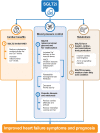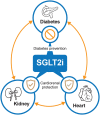Is There a Diabetes-Kidney-Heart Continuum? Perspectives From the Results of the Cardiovascular and Renal Outcome Clinical Trials With SGLT2 Inhibitors
- PMID: 34631819
- PMCID: PMC8494970
- DOI: 10.3389/fcvm.2021.716083
Is There a Diabetes-Kidney-Heart Continuum? Perspectives From the Results of the Cardiovascular and Renal Outcome Clinical Trials With SGLT2 Inhibitors
Abstract
Heart failure is associated with a substantial risk of mortality and morbidity. Findings from recent cardiovascular outcome trials have shown promise for sodium-glucose cotransporter-2 (SGLT2) inhibitors in preventing heart failure in patients with type 2 diabetes mellitus (T2DM). Notably, the benefits of SGLT2 inhibitors were consistent despite the presence of risk factors like atherosclerosis. Increasing evidence suggests that SGLT2 inhibitors may confer their cardioprotective effects through multiple mechanisms, ranging from improving cardiac and vascular performance to metabolism. The reduction of heart failure risk by SGLT2 inhibitors may also be attributed to the preservation of renal function. Indeed, renal insufficiency is a frequent comorbidity of patients with heart failure and T2DM; hence, the natriuretic and kidney protective effects offered by SGLT2 inhibitors may contribute to limiting adverse cardiac outcomes. In this article, we discuss the latest findings from the cardiovascular and renal outcome trials, paying special attention to the interlink between heart and kidney function, and how effective treatment of heart failure-irrespective of T2DM diagnosis-may require agents that offer both cardiac and renal protection.
Keywords: CVOT; SGLT2 inhibitors; heart failure; renal insufficiency; type 2 diabetes mellitus.
Copyright © 2021 Bao, Gao, Xie and Li.
Conflict of interest statement
This study received funding from AstraZeneca. The funder had the following involvement with the study: funding development of the commentary and editorial assistance. The authors declare that the research was conducted in the absence of any commercial or financial relationships that could be construed as a potential conflict of interest.
Figures


Similar articles
-
Exploring the Cardiovascular Benefits of Sodium-Glucose Cotransporter-2 (SGLT2) Inhibitors: Expanding Horizons Beyond Diabetes Management.Cureus. 2023 Sep 30;15(9):e46243. doi: 10.7759/cureus.46243. eCollection 2023 Sep. Cureus. 2023. PMID: 37908957 Free PMC article. Review.
-
SGLT2 Inhibition for CKD and Cardiovascular Disease in Type 2 Diabetes: Report of a Scientific Workshop Sponsored by the National Kidney Foundation.Am J Kidney Dis. 2021 Jan;77(1):94-109. doi: 10.1053/j.ajkd.2020.08.003. Epub 2020 Oct 26. Am J Kidney Dis. 2021. PMID: 33121838
-
How Do SGLT2 (Sodium-Glucose Cotransporter 2) Inhibitors and GLP-1 (Glucagon-Like Peptide-1) Receptor Agonists Reduce Cardiovascular Outcomes?: Completed and Ongoing Mechanistic Trials.Arterioscler Thromb Vasc Biol. 2020 Mar;40(3):506-522. doi: 10.1161/ATVBAHA.119.311904. Epub 2020 Jan 30. Arterioscler Thromb Vasc Biol. 2020. PMID: 31996025 Review.
-
Mechanisms of Protective Effects of SGLT2 Inhibitors in Cardiovascular Disease and Renal Dysfunction.Curr Top Med Chem. 2019;19(20):1818-1849. doi: 10.2174/1568026619666190828161409. Curr Top Med Chem. 2019. PMID: 31456521 Review.
-
Renal and Cardiac Implications of Sodium Glucose Cotransporter 2 (SGLT2) Inhibitors: The State of the Science.Ann Pharmacother. 2018 Dec;52(12):1238-1249. doi: 10.1177/1060028018783661. Epub 2018 Jun 17. Ann Pharmacother. 2018. PMID: 29911393
Cited by
-
Effect of Anti-Diabetic Medication Use on Sepsis Risk in Type 2 Diabetes Mellitus: A Multivariate Analysis.Geriatrics (Basel). 2025 Aug 7;10(4):108. doi: 10.3390/geriatrics10040108. Geriatrics (Basel). 2025. PMID: 40863575 Free PMC article.
References
-
- Scirica BM, Mosenzon O, Bhatt DL, Udell JA, Steg PG, McGuire DK, et al. . Cardiovascular outcomes according to urinary albumin and kidney disease in patients with type 2 diabetes at high cardiovascular risk: observations from the SAVOR-TIMI 53 trial. JAMA Cardiol. (2018) 3:155–63. 10.1001/jamacardio.2017.4228 - DOI - PMC - PubMed
LinkOut - more resources
Full Text Sources

